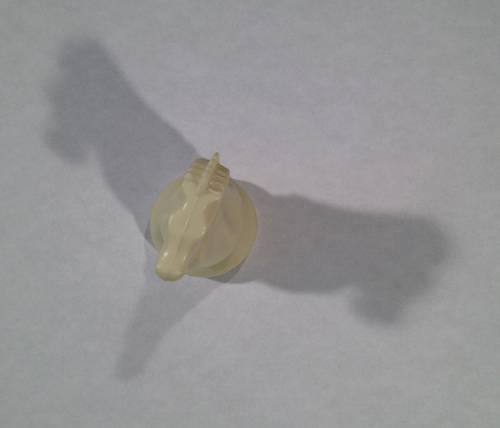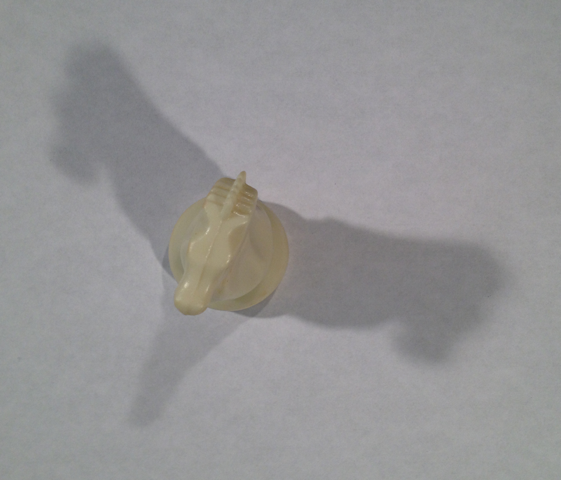Mapping Out the State of a Quantum System
The wave function is the physicist’s usual choice to characterize the state of a quantum system. But a different mathematical object, called a density matrix, is required for systems that are in mixed states, which are a mixture of other, pure quantum states. An example of a pure state is a beam of horizontally or vertically polarized photons, whereas a mixed state would be an uncorrelated statistical mixture of both polarizations. A mixed state would also apply to a system quantum mechanically entangled with its environment. The density matrix provides a complete description of a mixed state, but it also applies to pure states. Usually, experimental measurements of density matrices are indirect reconstructions using data acquired from a series of different kinds of measurements. Jeff Lundeen and colleagues [1] from the University of Ottawa, Canada, have come up with an alternative measurement technique to determine the density matrix of a quantum system, which they call “direct measurement.” The researchers demonstrate their technique by measuring the density matrix of polarized photons, one density-matrix element at a time.
In order to carry out a characterization of the state of a quantum system, a single measurement is not sufficient. Multiple measurements must be made of different physical observables to explore all independent degrees of freedom of the system, each of which is associated with a parameter describing the quantum state. To obtain a density matrix, many more parameters must be determined than for a wave function. There are different approaches used to determine these parameters, all of which fall under the general umbrella of “quantum state tomography” because they are similar to looking at how an object casts its shadow from different directions (see Fig. 1).
Lundeen and co-workers have a different kind of quantum tomography scheme. Like conventional quantum tomography, it involves multiple measurements carried out on many copies of the same (unknown) quantum state. But sets of measurements are made on single copies of the system to give access to the different parameters of the quantum state. In usual quantum measurements, whenever the state is measured, it is disturbed and “collapses.” The procedure must therefore be repeated on a fresh system to obtain information about a different parameter. However, if the strength of the measurement is reduced, the amount of disturbance is also reduced but at the price of decreasing the amount of information obtained. In the “very weak” measurement limit, with many realizations of the measurement, information can be acquired about a state parameter with minimal disturbance, so a subsequent measurement on the same system can reveal information about another parameter of the original (minimally disturbed) state with good fidelity.
The method relies on the fact that the average over the realizations of a weak measurement will be the same as the usual “strong” measurement average, even with subsequent measurements added on [2]. Lundeen’s group selected as their system a beam of photons polarized along an unknown direction. To determine the 2×2 polarization density matrix, the team chose three varying-strength sequential measurements, using different optical elements. The measurements were chosen so that the outcomes—averaged over many, many times—provide complementary information about the full polarization state, not just one slice (or projection) of it. This feature puts the “direct” in their “direct measurement technique”: weighted averaging of the joint measurement data yields the desired density-matrix element. It should be stressed that the method is quite different in philosophy to standard quantum tomography. In usual tomography, strong measurements of the polarization are taken separately along several different axes, and the results are combined in a reconstruction algorithm that globally generates all matrix elements at once. In the new experiment, the use of joint weak measurements allows the elements to be reconstructed one at a time. The approach is a generalization of the authors’ earlier quantum tomography technique to measure the wave function [3].
By applying their technique to density matrices, the Lundeen group has greatly extended the usefulness of the approach to generic systems interacting with an environment. Since their experiments are done on optical systems with no single-photon effects, the results have a classical wave-optics interpretation. It would be interesting to see similar methods applied to other quantum systems, such as atoms or superconducting systems, for which there is no classical wave explanation. If one could “directly measure” the wave function of an atom, for example, would that imply that the wave function exists as an ontological reality, as some have suggested [4]? In my opinion, this family of experiments [1, 3, 4] does not substantiate that interpretation. Their technique is a kind of tomography of the quantum state, and it is not fundamentally different from any other kind of tomography. In all cases, a statistical inference about a prepared state is made from repeated experiments, which yield actual real numbers as results.
Another question that should be answered is a quantitative head-to-head comparison of this technique to standard tomography methods in terms of speed and accuracy, given comparable resources, although some progress has been made in this direction [5]. It would also be interesting to examine ways to improve the statistical efficiency of the method by optimally using the information in the readout results.
Finally, other investigations have shown an incredible utility of the authors’ method for characterizing high-dimensional quantum states (those which have a very large number of parameters). The Howell group and the Boyd group, at the University of Rochester and University of Ottawa, have incorporated the technique of compressive sensing into Lundeen and colleagues’ earlier method to very rapidly sense a 256×256-pixel optical wave front [6] and a photonic state of one million dimensions [7], which is prohibitive with standard tomographic techniques. Recent work from the Howell group has also pushed the measurement of quantum entangled states into very high dimensions, using compressive sensing techniques [8]. Lundeen and colleagues’ creative method [1] gives quantum tomography a new, local approach to map out states that are both high dimensional and possibly entangled. The technique has great promise in helping in the resource-intensive task of tomographic reconstruction of an unknown state.
This research is published in Physical Review Letters.
References
- G. S. Thekkadath, L. Giner, Y. Chalich, M. J. Horton, J. Banker, and J. S. Lundeen, “Direct Measurement of the Density Matrix of a Quantum System,” Phys. Rev. Lett. 117, 120401 (2016).
- J. Dressel, S. Agarwal, and A. N. Jordan, “Contextual Values of Observables in Quantum Measurements,” Phys. Rev. Lett. 104, 240401 (2010).
- J. S. Lundeen, B. Sutherland, A. Patel, C. Stewart, and C. Bamber, “Direct Measurement of the Quantum Wavefunction,” Nature 474, 188 (2011).
- C. Bamber, “Direct Measurement of the Wavefunction of a Single Photon,” in Frontiers in Optics 2011/Laser Science XXVII, OSA Technical Digest (Optical Society of America, Washington DC, 2011)[Amazon][WorldCat].
- L. Maccone and C. C. Rusconi, “State Estimation: A Comparison Between Direct State Measurement and Tomography,” Phys. Rev. A 89, 022122 (2014).
- G. A. Howland, D. J. Lum, and J. C. Howell, “Compressive Wavefront Sensing with Weak Values,” Opt. Express 22, 18870 (2014).
- Z. Shi, M. Mirhosseini, J. Margiewicz, M. Malik, F. Rivera, Z. Zhu, and R. W. Boyd, “Scan-Free Direct Measurement of an Extremely High-Dimensional Photonic State,” Optica 2, 388 (2015).
- G. A. Howland, S. H. Knarr, J. Schneeloch, D. J. Lum, and John C. Howell, “Compressively Characterizing High-Dimensional Entangled States with Complementary, Random Filtering,” Phys. Rev. X 6, 021018 (2016).





